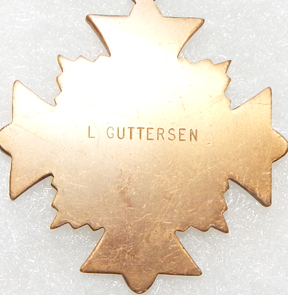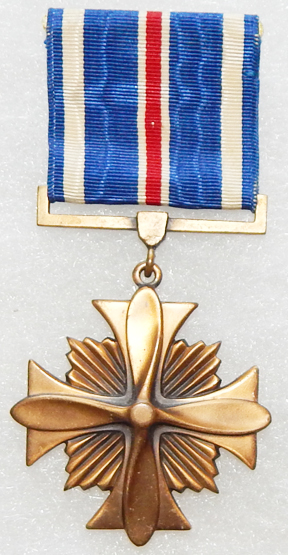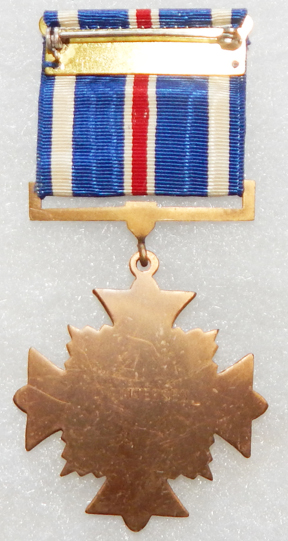Vietnam US Air Force Named Distinguished Flying Cross To Prisoner Of War. Standard issue DFC. Has typical Vietnam style engraving on reverse. Belonged to an F4 phantom pilot who was with the 497th Tactical Fighter Squadron and was shot down on a night time mission on Feb. 23, 1968. Shows minor use and wear. Pin back.
Below is more info from pownetwork:
SYNOPSIS: Laird Guttersen was born at White Bear Lake, Minnesota, on July 4, 1925. He entered the Army Air Corps in August, 1943 to pursue a dream - flying. During World War II he flew B-25s and in Korea flew F-51s and F-86s.
Following the Korean War, Guttersen was an Air University lecturer at Maxwell Air Force Base where his specialty was POW Affairs and, in addition, he helped develop the manual on teaching the Code of Conduct. He served on all levels of command from Squadron and the Air Staff at the Pentagon.
On Guttersen's first tour of Vietnam (1965-1966), he flew C130s. While flying F-4D's during his second tour, he was shot down twice, the first a night mission on December 15, 1967, when he and his "guy in back" were rescued from the Gulf of Tonkin by the combined efforts of the Air Force, Army, and Navy. On February 23, 1968, during a mission close to Hanoi, Guttersen's aircraft was hit by a missile from a MiG 21. ejected near Haiphong and evaded the enemy for 10 hours. His backseater, Myron L. Donald was also captured. While imprisoned, he was held in solitary confinement for 27 months and he and Donald were released in March 1973 with other American POWs.
Guttersen's research at the Air University into the treatment of war prisoners, and the psychological torture and manipulaton they must face, served him well after he was shot down in February 1968. Although he understood what was being done to him through torture and deprivation, Guttersen frankly states, "It's not a matter of IF you can be broken...it's only a matter of how long it takes."
But his understanding of the tactics used by the Vietnamese helped him to survive and maintain a positive attitude - that and a message he saw scratched on the wall while lying on the prison floor in agony with a broken back. The message said, "Keep the faith, baby." Guttersen says that message helped him get through "that minute, that hour, that day" and days following. When pilots began arriving later in the war speaking of POW bracelets and U.S. public support, Guttersen knew America would do everything it could to free him. He remembers that support and tries to promote it today.
Upon his return to the U.S., Guttersen was directed not to become involved with POW/MIA organizations. Guttersen, however, believed Americans were still being held, and persisted in speaking out on their behalf. He voluntarily retired from the Air Force as a Colonel in 1974 and has been an outspoken advocate for Americans he believes are still held captive in Southeast Asia since that time






